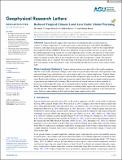Files in this item
Reduced tropical climate land area under global warming
Item metadata
| dc.contributor.author | Adam, Ori | |
| dc.contributor.author | Liberty‐Levi, Noga | |
| dc.contributor.author | Byrne, Michael | |
| dc.contributor.author | Birner, Thomas | |
| dc.date.accessioned | 2023-03-30T15:30:02Z | |
| dc.date.available | 2023-03-30T15:30:02Z | |
| dc.date.issued | 2023-03-28 | |
| dc.identifier | 283923556 | |
| dc.identifier | cd404bdf-ae8f-489d-903f-386876f5a9ca | |
| dc.identifier | 85152570032 | |
| dc.identifier.citation | Adam , O , Liberty‐Levi , N , Byrne , M & Birner , T 2023 , ' Reduced tropical climate land area under global warming ' , Geophysical Research Letters , vol. 50 , no. 6 , e2022GL102546 . https://doi.org/10.1029/2022gl102546 | en |
| dc.identifier.issn | 0094-8276 | |
| dc.identifier.other | Jisc: 987006 | |
| dc.identifier.other | publisher-id: grl65611 | |
| dc.identifier.other | society-id: 2022gl102546 | |
| dc.identifier.other | ORCID: /0000-0001-9019-3915/work/132214392 | |
| dc.identifier.uri | https://hdl.handle.net/10023/27302 | |
| dc.description | Funding: OA acknowledges support by ISF Grant 1022/21. | en |
| dc.description.abstract | Regions along the edges of the tropics host vast populations and ecosystems which are sensitive to climate change. Here we examine the extent of tropical land areas in the ERA5 and MERRA‐2 reanalyses and in high‐emission scenarios of 45 models participating in phases 5 and 6 of the Coupled Model Intercomparison Project (CMIP5/6). Based on the definition of tropical climate land areas as regions where the diurnal temperature range exceeds the seasonal temperature range, we find a net reduction of tropical land area with global warming. This change is primarily due to an increased seasonal temperature range driven by enhanced summer warming, which in turn is largely driven by reduced evaporative cooling. The reduction of tropical climate area is consistent with a narrowing of the tropical rain belt and with an equatorward and poleward expansion of the subtropical dry zones. Understanding the links between these trends requires further study. | |
| dc.format.extent | 9 | |
| dc.format.extent | 2533611 | |
| dc.language.iso | eng | |
| dc.relation.ispartof | Geophysical Research Letters | en |
| dc.subject | Tropical widening | en |
| dc.subject | Subtropical widening | en |
| dc.subject | Subtropical dry zones | en |
| dc.subject | Tropical land area | en |
| dc.subject | Tropical rain belt | en |
| dc.subject | Hadley circulation | en |
| dc.subject | GE Environmental Sciences | en |
| dc.subject | 3rd-DAS | en |
| dc.subject | SDG 13 - Climate Action | en |
| dc.subject | SDG 15 - Life on Land | en |
| dc.subject | MCC | en |
| dc.subject.lcc | GE | en |
| dc.title | Reduced tropical climate land area under global warming | en |
| dc.type | Journal article | en |
| dc.contributor.institution | University of St Andrews. School of Earth & Environmental Sciences | en |
| dc.contributor.institution | University of St Andrews. Centre for Energy Ethics | en |
| dc.identifier.doi | https://doi.org/10.1029/2022gl102546 | |
| dc.description.status | Peer reviewed | en |
This item appears in the following Collection(s)
Items in the St Andrews Research Repository are protected by copyright, with all rights reserved, unless otherwise indicated.

